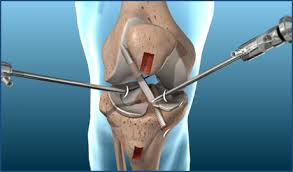ANTERIOR CRUCIATE LIGAMENT RECONSTRUCTION
The goal of ACL reconstruction surgery is to tighten your knee and to restore its stability.
Anterior cruciate ligament reconstruction consists of replacing the torn ligament with another tendon from your body. Hamstring tendons are most commonly used and they are part of the muscle located on the back of your thigh. Patellar tendon or a tendon from a donor are other available options.

The procedure is performed under general anaesthesia or sedation with a nerve block. The reconstruction is performed under arthroscopic or keyhole surgery. 3-4 cuts will be made around the knee. An arthroscope, a tube with a small video camera on the end, is inserted through one incision to see the inside of the knee joint. Along with the arthroscope, a sterile solution is pumped into the joint to expand it enabling the surgeon to have a clear view and space to work inside the joint.
The torn ACL will be removed and the pathway for the new ACL is prepared. Small holes are drilled into the top on the tibia (shin bone) and bottom of the femur (thigh bone) where these bones come together at the knee joint. Then the new ligament is pulled through the pre-drilled holes in the tibia and femur and fixed into the bone with screws to hold it into place while it heals. The incisions are then closed with sutures and a dressing is placed.
Possible risks and complications associated with ACL reconstruction include:
-
Numbness
-
Infection
-
Blood clots
-
Nerve and blood vessel damage
-
Failure of the graft
-
Loosening of the graft
-
Decreased range of motion
-
Pain in the knee
